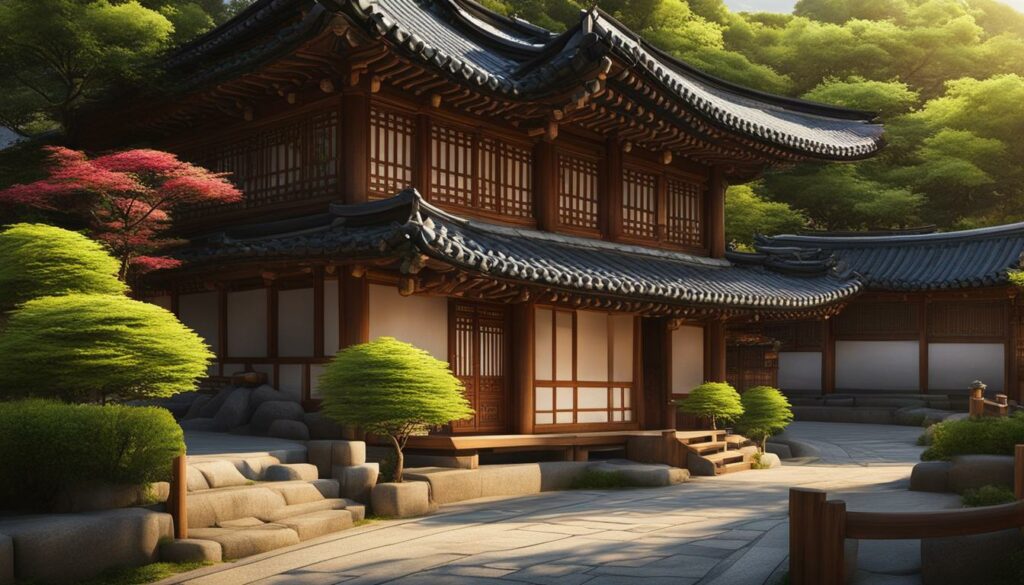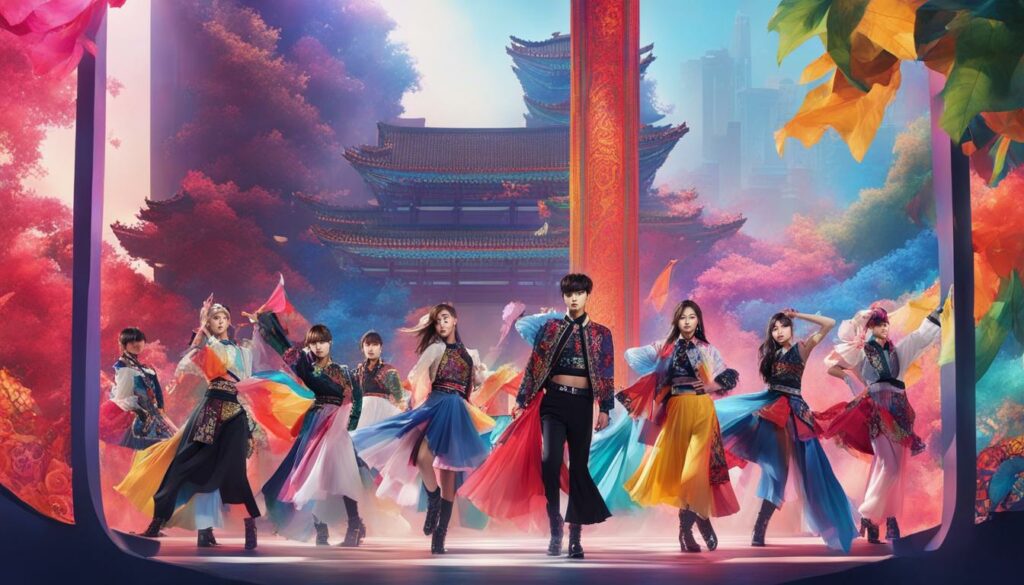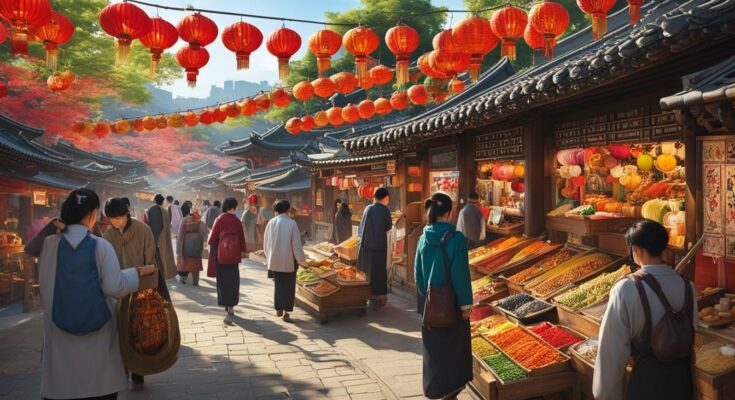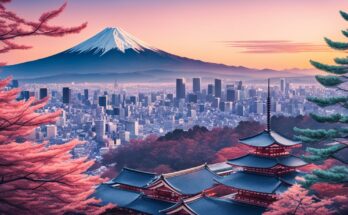South Korea is a country steeped in history and traditions, offering a fascinating glimpse into the rich tapestry of Korean culture. From its cultural heritage sites to its deep-rooted traditions, South Korea is a treasure trove of unique experiences waiting to be explored.
Immerse yourself in the wonders of South Korea’s cultural heritage sites, which have been recognized by UNESCO for their significance. Explore ancient palaces like Changdeokgung and historic sites like Gyeongju, and witness firsthand the architectural marvels that have stood the test of time.
Delve into Korean history and traditions, as you discover the artistic sensibility that has shaped the country’s vibrant cultural legacy. From traditional art forms like Korean Dansaekhwa to the captivating Silla tomb murals, you’ll be captivated by the creativity and innovation that have flourished throughout the centuries.
Indulge in the flavors of Korean cuisine, renowned for its bold and vibrant flavors. From sizzling barbecues to spicy kimchi, each dish tells a story of tradition and pride. Experience the joy of participating in traditional festivals, where you can witness the vibrancy and diversity of Korean culture firsthand.
Finally, immerse yourself in the modern cultural influences of South Korea, particularly the global sensation of K-pop. Discover why BTS and other Korean artists have taken the music industry by storm, and witness the far-reaching impact of South Korea’s cultural contributions.
Join us on a journey through South Korea’s rich cultural heritage and traditions, and discover the beauty and depth of this extraordinary country.
Key Takeaways:
- South Korea boasts a wealth of cultural heritage sites recognized by UNESCO.
- Traditional Korean art forms like Korean Dansaekhwa showcase the country’s artistic excellence.
- Korean cuisine offers a delightful blend of flavors and dishes, steeped in tradition.
- Participating in traditional festivals provides a firsthand glimpse into the vibrancy of Korean culture.
- K-pop has become a global phenomenon, showcasing the modern cultural influences of South Korea.
Traditional Korean Art Forms
Korea has a rich history of traditional art forms that continue to captivate audiences around the world. One notable art form is Korean Dansaekhwa, which refers to monochrome paintings. These paintings gained global recognition in recent years for their unique artistic sensibility. Dansaekhwa showcases the evolution of Korean art over centuries, with its origins dating back to the Three Kingdoms Period.
During this period, Korean artists began experimenting with new techniques and materials, resulting in the creation of breathtaking artwork. The Silla tomb murals, for example, offer a glimpse into the artistic style of the time, featuring intricate designs and vibrant colors. As Korean art evolved through the Unified Silla and Joseon dynasties, it continued to be influenced by various cultural and historical factors, resulting in innovative and distinct art forms.
One of the distinguishing features of traditional Korean art is its emphasis on simplicity and minimalism. The use of monochrome colors and subtle brushstrokes allows the viewer to focus on the essence of the artwork. This aesthetic approach, combined with the meticulous attention to detail, creates a sense of tranquility and harmony. Traditional Korean art forms are not only visually captivating but also reflect the country’s rich cultural heritage and artistic prowess.
Table: Comparison of Traditional Korean Art Forms
| Art Form | Description |
|---|---|
| Dansaekhwa | Monochrome paintings that emphasize simplicity and contemplation |
| Silla Tomb Murals | Intricate and colorful tomb murals from the Silla dynasty |
| Joseon Dynasty Paintings | Artworks from the Joseon dynasty showcasing cultural and historical themes |
| Goryeo Celadon | Distinctive ceramic ware known for its beautiful jade color |
| Hanbok | Traditional Korean clothing characterized by vibrant colors and graceful lines |
South Korea’s Cultural Heritage Sites
South Korea boasts a rich collection of cultural heritage sites that offer a fascinating glimpse into the country’s history and traditions. From ancient palaces to sacred shrines and stunning fortresses, these sites showcase the enduring beauty and significance of Korean culture. Let’s explore some of South Korea’s most notable cultural heritage sites:
Gyeongju Historic Areas
Gyeongju, also known as the “museum without walls,” is a treasure trove of archaeological remains from the ancient Silla kingdom. This historic city is home to numerous UNESCO World Heritage sites, including the famous Bulguksa Temple and the Seokguram Grotto. The Gyeongju Historic Areas offer visitors a chance to immerse themselves in the rich history and architectural splendor of the Silla dynasty.
Changdeokgung Palace
Located in the heart of Seoul, Changdeokgung Palace is a living testament to Korea’s royal heritage. This UNESCO World Heritage site features beautifully preserved structures, including the iconic Huwon (Secret Garden) which offers a serene escape from the bustling city. As you explore the palace grounds, you’ll gain a deeper appreciation for the intricate craftsmanship and architectural brilliance of the Joseon dynasty.
Jongmyo Shrine
The Jongmyo Shrine is a sacred place of worship and a UNESCO World Heritage site dedicated to the ancestral spirits of the Joseon kings. This remarkable shrine complex reflects the importance of Confucianism in Korean culture and offers visitors a profound cultural and spiritual experience. The annual Jongmyo Jerye ritual, a reenactment of ancient royal ceremonies, is a truly awe-inspiring event.
Hwaseong Fortress
Built in the late 18th century, Hwaseong Fortress in Suwon is a remarkable example of military architecture from the Joseon dynasty. This UNESCO World Heritage site showcases the innovative use of both Eastern and Western military construction techniques. Take a leisurely stroll along the fortress walls and admire the panoramic views of the city, a testament to the ingenuity of Korean engineers of the time.
Hanok Villages and Traditional Korean Architecture
Immerse yourself in the charm of traditional Korean architecture by exploring the captivating hanok villages of South Korea. Two of the most popular destinations for experiencing this architectural treasure are the Bukchon Hanok Village in Seoul and the Jeonju Hanok Village. These living museums allow visitors to step back in time and witness the beauty of Korea’s ancient architectural heritage.
The Bukchon Hanok Village, nestled between Gyeongbokgung Palace and Changdeokgung Palace, boasts over 900 traditional wooden houses. Strolling through the narrow alleys of this historic neighborhood, you’ll be transported to a bygone era. The village offers a glimpse into the lives of the noble class, with some hanoks converted into museums, cafes, and traditional guesthouses.
The Jeonju Hanok Village, located in the city of Jeonju, is renowned for its well-preserved hanok houses. This picturesque village is a treasure trove of traditional architecture, with over 800 hanoks showcasing the elegant design and craftsmanship of the past. Visitors can experience traditional Korean culture firsthand by participating in a hanbok (traditional Korean clothing) rental, traditional tea ceremonies, or even trying their hand at making traditional crafts.
| Hanok Village | Location | Features |
|---|---|---|
| Bukchon Hanok Village | Seoul | – Over 900 traditional wooden houses – Museums, cafes, and guesthouses – Close proximity to Gyeongbokgung Palace and Changdeokgung Palace |
| Jeonju Hanok Village | Jeonju | – Well-preserved hanok houses – Over 800 hanoks – Traditional cultural experiences and workshops |
These hanok villages are not only architectural wonders but also a gateway to understanding and appreciating traditional Korean culture. Whether you’re admiring the intricate wooden lattice work, enjoying the tranquility of a traditional courtyard, or savoring the flavors of authentic Korean cuisine in a hanok restaurant, a visit to these villages is a truly immersive experience.

Exploring the hanok villages of South Korea is like stepping into a living time capsule. These beautifully preserved traditional neighborhoods offer a glimpse into the rich architectural heritage of the country. From the intricate details of wooden craftsmanship to the peaceful ambiance of traditional courtyards, there is a sense of tranquility and beauty that captivates visitors. The hanok villages are not just a reflection of the past, but also a testament to the enduring legacy of Korean architecture.
Cultural Experiences in South Korea
South Korea offers a myriad of cultural experiences for visitors to enjoy. One of the highlights is the opportunity to indulge in the country’s renowned cuisine. From sizzling barbecues and spicy kimchi to delectable street food, Korean food is a feast for the senses. The cuisine reflects the country’s rich history and diverse regional flavors.
Traditional festivals are another way to immerse oneself in Korean culture. The Jinju Lantern Festival, held in the historic city of Jinju, showcases a mesmerizing display of lanterns, cultural performances, and traditional rituals. The Boryeong Mud Festival, on the other hand, is a playful event where visitors can enjoy mud wrestling, mud slides, and various mud-related activities.
For those looking to have a deeper understanding of Korean traditions and customs, cultural exchange programs provide a unique opportunity. These programs allow participants to engage with local communities, learn traditional arts and crafts, experience traditional music and dance, and even stay with a Korean host family. It’s a chance to immerse oneself in the daily life and customs of the country, fostering cross-cultural understanding and appreciation.
The Vibrant Gastronomy of Korea
Korean cuisine is a treasure trove of flavors, textures, and colors. It is characterized by the use of fresh ingredients, balanced flavors, and a harmonious blend of spices. Some signature dishes include:
- Bibimbap: A popular dish consisting of rice topped with an assortment of vegetables, meat, and a fried egg, served with a spicy sauce.
- Bulgogi: Thinly sliced marinated beef or pork, grilled to perfection and often wrapped in lettuce leaves with a variety of condiments.
- Kimchi: A staple in Korean cuisine, kimchi is a fermented side dish made with vegetables, most commonly cabbage, and flavored with chili peppers, garlic, and other seasonings.
- Tteokbokki: Spicy rice cakes cooked in a savory sauce, often served with fish cakes, vegetables, and boiled eggs.
Korean cuisine is not just about the flavors, but also the communal dining experience. Sharing a meal with friends and family is an integral part of Korean culture, fostering connections and strengthening bonds. So, don’t miss the chance to savor the delicious and culturally significant dishes of Korea during your visit.
Traditional Festivals: A Window into Korean Culture
Korea is known for its vibrant and colorful festivals, which offer a unique glimpse into the country’s cultural heritage. Here are some of the most popular traditional festivals:
| Festival | Date | Location |
|---|---|---|
| Jinju Lantern Festival | October | Jinju |
| Boryeong Mud Festival | July | Boryeong |
| Andong Mask Dance Festival | September/October | Andong |
| Hwacheon Sancheoneo Ice Festival | January/February | Hwacheon |
| Gwangju World Kimchi Culture Festival | October | Gwangju |
These festivals celebrate various aspects of Korean culture, including traditional music, dance, food, and customs. They offer a chance to witness captivating performances, participate in hands-on activities, and gain a deeper understanding of the country’s traditions.
Cultural Exchange Programs: Immersion in Korean Traditions
If you’re seeking a more immersive cultural experience, consider participating in a cultural exchange program in South Korea. These programs provide a unique opportunity to engage with local communities and explore various aspects of Korean culture. Here are some popular cultural exchange programs:
- Temple Stay: Experience the life of a Buddhist monk by staying in a temple, practicing meditation, and learning about Buddhist teachings.
- Hanbok Experience: Dress up in traditional Korean attire, known as hanbok, and take part in cultural activities like tea ceremonies and traditional games.
- Korean Traditional Music and Dance Classes: Learn to play traditional musical instruments like the gayageum or participate in traditional dance classes to immerse yourself in the cultural arts.
- Korean Language Exchange: Engage in language exchange programs where you can learn Korean from locals while sharing your language and culture with them.
These programs offer a deeper connection with the local culture, allowing you to learn, appreciate, and participate in the rich traditions of South Korea.
Modern Cultural Influences in South Korea
South Korea’s cultural influence extends far beyond its traditional heritage. In recent years, the rise of K-pop and the Korean entertainment industry has captivated audiences worldwide, making a significant impact on the global stage. With artists like BTS and BLACKPINK, South Korean music has topped charts and gained millions of fans around the globe. The success of K-pop reflects the global popularity of South Korean culture, reaching far beyond Asia and into the United States, Europe, South America, and beyond.
Through catchy melodies, synchronized choreography, and eye-catching music videos, K-pop has gained international recognition for its innovation and creativity. The influence of K-pop goes beyond just music; it has become a cultural phenomenon that encompasses fashion, beauty, and lifestyle trends. K-pop idols are seen as style icons, leading to collaborations with international brands and creating new trends in the fashion industry.
The Korean entertainment industry as a whole has expanded its reach through drama series, movies, and variety shows. Korean dramas, known as K-dramas, have gained a massive following globally, with fans falling in love with the captivating storylines and talented actors. South Korea’s film industry has also received critical acclaim, with movies like Parasite winning prestigious awards, including the Palme d’Or at the Cannes Film Festival.
K-pop’s Global Impact: Key Facts
- K-pop has gained immense popularity worldwide, with dedicated fan bases in countries across the globe.
- The success of K-pop groups like BTS has led to sold-out stadium tours and record-breaking music videos on YouTube.
- K-pop’s influence goes beyond music, shaping fashion trends, beauty standards, and even travel preferences.
- Many international artists have collaborated with K-pop stars, further expanding the genre’s global reach.
“K-pop has truly become a global force, transcending language barriers and connecting diverse cultures through the power of music and performance.” – Industry Expert
Table: K-pop’s Global Success
| Year | Key Milestones |
|---|---|
| 2012 | Gangnam Style by Psy becomes the first K-pop song to reach 1 billion views on YouTube. |
| 2017 | BTS wins the Billboard Music Award for Top Social Artist, becoming the first K-pop group to achieve this honor. |
| 2018 | BTS becomes the first K-pop group to top the Billboard 200 chart with their album “Love Yourself: Tear.” |
| 2019 | BLACKPINK becomes the first K-pop girl group to perform at the Coachella Valley Music and Arts Festival. |
| 2020 | BTS’s “Dynamite” becomes the first song by a South Korean act to debut at No. 1 on the Billboard Hot 100 chart. |
As South Korea continues to make waves in the global entertainment industry, its modern cultural influences pave the way for a new era of cross-cultural exchange and appreciation. The impact of K-pop and Korean entertainment serves as a testament to the power of cultural diplomacy, bringing people together through shared music, fashion, and entertainment.

Conclusion
South Korea offers a wealth of tourist attractions that showcase its rich cultural heritage and traditions. From UNESCO-listed heritage sites to vibrant festivals and immersive cultural experiences, there is something for every traveler to enjoy. The country’s ancient palaces, such as the Changdeokgung Palace, provide a glimpse into its regal past, while the delicious Korean cuisine tantalizes the taste buds.
Moreover, South Korea’s cultural diplomacy plays a significant role in promoting its unique heritage and fostering international understanding. Through cultural exchange programs and initiatives, the country not only shares its traditions with the world but also creates opportunities for cross-cultural learning and appreciation. This cultural diplomacy helps build bridges between nations and promotes peace and understanding.
As visitors explore South Korea’s diverse cultural tapestry, they not only enrich their own travel experiences but also contribute to the preservation and promotion of its cultural heritage for future generations. By immersing themselves in the country’s rich traditions and engaging with its people, travelers become cultural ambassadors, strengthening the bond between nations through shared experiences and appreciation.
Unraveling the Intricate Gyeongbokgung Palace History – A Fascinating Journey
FAQ
What are some traditional Korean art forms?
Traditional Korean art forms include Korean Dansaekhwa, also known as monochrome paintings, which have gained global recognition in recent years. The Three Kingdoms Period marked the beginning of this artistic excellence, with artifacts and tomb murals reflecting the unique style of the time. From the Unified Silla to the Joseon dynasty, Korean art continued to flourish and evolve, leaving behind a remarkable legacy of creativity and innovation.
What are some of South Korea’s cultural heritage sites?
South Korea is home to numerous cultural heritage sites that showcase the country’s rich history and traditions. Some notable examples include Gyeongju, the ancient capital of the Silla kingdom, known as a “museum without walls” due to its abundance of archaeological remains. Changdeokgung Palace, a UNESCO World Heritage site, is known for its well-preserved structures and beautiful traditional garden. Jongmyo Shrine, the royal ancestral shrine of the Joseon dynasty, is a testament to the importance of Confucianism in Korean culture. Hwaseong Fortress and Seokguram Grotto and Bulguksa Temple are also remarkable sites with architectural and religious significance.
What are hanok villages and where can they be found?
Hanok villages are living museums that allow visitors to experience the charm of traditional Korean architecture. Two popular hanok villages are Bukchon Hanok Village in Seoul and Jeonju Hanok Village. These villages are home to beautifully preserved traditional wooden houses, offering a glimpse into Korea’s past. In addition to the hanok villages, Seongyojang House in Gangneung provides a unique opportunity to experience the daily life of an upper-class family during the Joseon dynasty.
What cultural experiences can visitors enjoy in South Korea?
South Korea offers a myriad of cultural experiences for visitors to enjoy. One highlight is the opportunity to indulge in the country’s renowned cuisine, from sizzling barbecues and spicy kimchi to delectable street food. Traditional festivals, such as the Jinju Lantern Festival and the Boryeong Mud Festival, showcase the vibrancy and diversity of Korean culture. Cultural exchange programs provide a chance to learn firsthand about Korean traditions and customs through cooking classes, traditional music and dance performances, and language exchanges.
What is the impact of K-pop and Korean entertainment industry globally?
South Korea’s cultural influence extends beyond its traditional heritage, with the rise of K-pop and the Korean entertainment industry captivating audiences worldwide. Groups like BTS have topped global music charts and garnered a massive following. K-pop music videos, featuring artists like BLACKPINK, have amassed millions of views on platforms like YouTube. The success of K-pop reflects the global popularity of South Korean culture, not just in Asia but also in the United States, Europe, South America, and beyond.
What role does cultural diplomacy play in South Korea?
Cultural diplomacy plays a significant role in promoting South Korea’s unique heritage and fostering international understanding. As travelers explore the country’s rich cultural tapestry, they not only gain a deeper appreciation for South Korea but also contribute to the preservation and promotion of its cultural heritage for future generations to enjoy.




